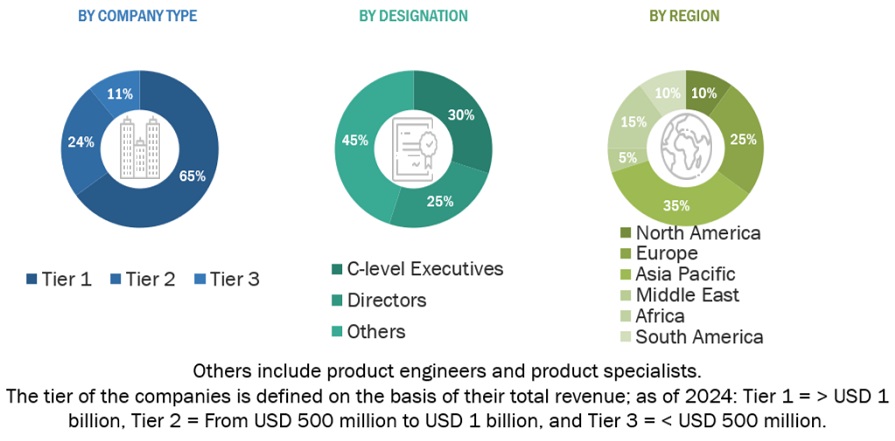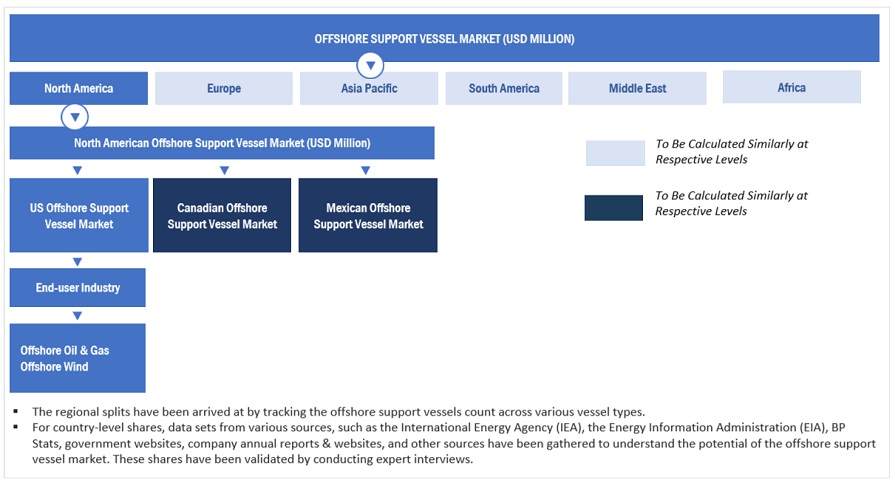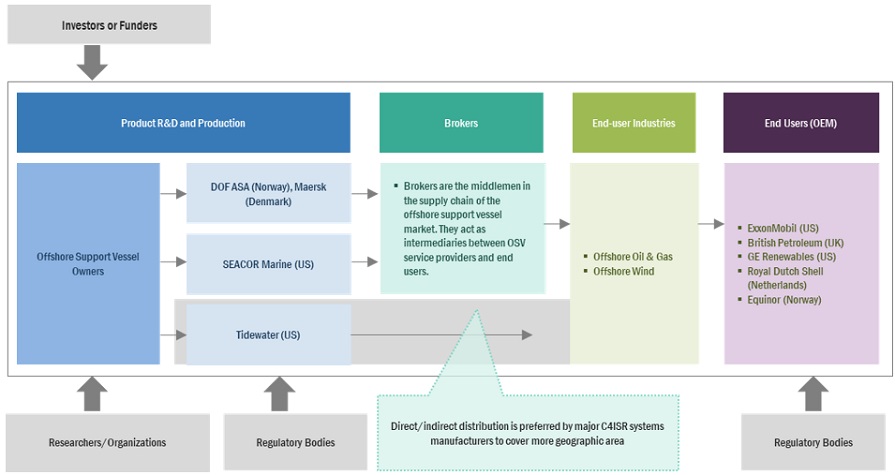The study involved major activities in estimating the current size of the offshore support vessel market. Exhaustive secondary research was done to collect information on the peer and parent markets. The next step was to validate these findings, assumptions, and sizing with industry experts across the value chain through primary research. Both top-down and bottom-up approaches were employed to estimate the total market size. Thereafter, market breakdown and data triangulation were used to estimate the market size of the segments and subsegments.
Secondary Research
This research study on the osv market involved the use of extensive secondary sources, directories, and databases, such as Hoover’s, Bloomberg, Factiva, IRENA, International Energy Agency, and Statista Industry Journal, to collect and identify information useful for a technical, market-oriented, and commercial study of the osv market. The other secondary sources included annual reports, press releases & investor presentations of companies, white papers, certified publications, articles by recognized authors, manufacturer associations, trade directories, and databases.
Primary Research
The osv market comprises several stakeholders, such as offshore support vessel manufacturers, technology providers, and technical support providers in the supply chain. The demand side of this market is characterized by the rising demand for storage solutions in various applications such as energy, mobility, industrial, and transportation. The supply side is characterized by rising demand for contracts from the industrial sector and mergers & acquisitions among big players. Various primary sources from both the supply and demand sides of the market were interviewed to obtain qualitative and quantitative information. Following is the breakdown of primary respondents:

To know about the assumptions considered for the study, download the pdf brochure
Offshore Support Vessel Market Size Estimation
Both top-down and bottom-up approaches were used to estimate and validate the total size of the osv market. These methods were also used extensively to estimate the size of various subsegments in the market. The research methodology used to estimate the market size includes the following:
-
The key players in the industry and market have been identified through extensive secondary research, and their market share has been determined through primary and secondary research.
-
The industry’s value chain and market size, in terms of value, have been determined through both primary and secondary research processes.
-
All percentage shares, splits, and breakdowns have been determined using secondary sources and verified through primary sources.
Offshore Support Vessel Market Size: Top-Down Approach

To know about the assumptions considered for the study, Request for Free Sample Report
Offshore Support Vessel Market Size: Bottom-Up Approach

Data Triangulation
After arriving at the overall market size from the above estimation process, the total market has been split into several segments and subsegments. Data triangulation and market breakdown processes have been employed to complete the overall market engineering process and arrive at the exact statistics for all the segments and sub-segments, wherever applicable. The data has been triangulated by studying various factors and trends from both the demand- and supply sides. Along with this, the market has been validated using both the top-down and bottom-up approaches.
Market Definition
An offshore support vessel (OSV) is specially designed to support offshore exploration, drilling, production, and construction activities in the oil & gas industry. These vessels provide a range of services, such as transportation of personnel, equipment and supplies, maintenance and repair, and oil spill response. OSVs are also used for specialized tasks such as platform installation, decommissioning, seismic surveying, providing firefighting, towing, and positioning of drilling rigs and other offshore structures, and subsea construction. These vessels are equipped with dynamic positioning systems to maintain their position in rough seas and are built to withstand harsh offshore conditions. Different types of offshore support vessels are used in offshore oil & gas and offshore wind applications. OSVs play a crucial role in offshore oil & gas and offshore wind farms by enabling safe and efficient operations.
Key Stakeholders
-
Offshore support vessel manufacturers and suppliers
-
Offshore support vessel operators
-
Offshore wind turbine manufacturers
-
Oil and gas companies
-
Wind farm owners, operators, and developers
-
Offshore support vessel consulting companies
-
Offshore logistics and ship authorities
-
Offshore platform operators
-
Associations and industry associations
-
Government and research organizations
-
Investment banks
State and National Regulatory Authorities Objectives of the Study
-
To forecast the osv market based on materials used, fuels used, type, application, end-user, and region in terms of value
-
To describe the market for four key regions: Asia Pacific, North America, Europe, and Rest of the World, along with their country-level market sizes in terms of value
-
To provide detailed information regarding key drivers, restraints, opportunities, and challenges influencing the growth of the market
-
To strategically analyze the micromarkets with respect to individual growth trends, prospects, and contributions to the overall market size
-
To provide the supply chain analysis, trends/disruptions impacting customers’ businesses, market map, ecosystem analysis, tariffs and regulations, pricing analysis, patent analysis, case study analysis, technology analysis, key conferences and events, trade analysis, Porter’s five forces analysis, key stakeholders and buying criteria, and regulatory analysis of osv market
-
To analyze opportunities for stakeholders in the offshore support vessel and draw a competitive landscape of the market
-
To benchmark market players using the company evaluation matrix, which analyzes market players on broad categories of business and product strategies adopted by them
-
To compare key market players with respect to product specifications and utility
-
To strategically profile key players and comprehensively analyze their market rankings and core competencies
-
To analyze competitive developments, such as contracts & agreements, investments & expansions, mergers & acquisitions, new product launches, partnerships, joint ventures & collaborations, in the osv market.
Available Customizations:
With the given market data, MarketsandMarkets offers customizations according to the specific requirements of companies. The following customization options are available for the report:
Product Analysis
-
Product Matrix, which provides a detailed comparison of the product portfolio of each company
Company Information
-
Detailed analyses and profiling of additional market players



Growth opportunities and latent adjacency in Offshore Support Vessel Market